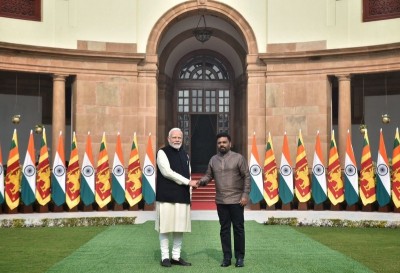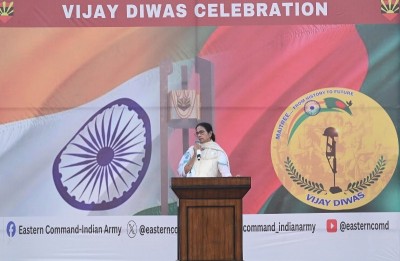India sets goal to grow country's electronics sector to $500 billion by end of this decade, says Modi while inaugurating SEMICON 2024
Indian PM Narendra Modi on Wednesday said India is set to play a major role in driving the global semiconductor industry.
With India’s electronics sector now valued at over $150 billion, the Prime Minister outlined a larger goal to grow the country’s electronics sector to $500 billion and create 6 million jobs by the end of this decade.
He said that this growth will directly benefit India’s semiconductor sector.
“Our goal is that 100% of electronic manufacturing should happen in India. India will make semiconductor chips and the finished product too,” he added.
He made the remark while inaugurating the SEMICON India 2024 at India Expo Mart in north Indian city of Greater Noida.
Addressing the gathering, the Prime Minister expressed gratitude to all members of SEMI saying that India is the eighth country in the world to organize an event related to the global semiconductor industry.
“This is the right time to be in India. You are at the right place at the right time,” PM Modi emphasized.
Highlighting the connection between the semiconductor industry and a diode where energy traverses only in one direction, the Prime Minister said that India’s semiconductor industry is equipped with special diodes where energy flows in both directions.
He explained that while industries invest and create value, the government on the other hand provides stable policies and Ease of Doing Business.
The Prime Minister said that India provides an integrated ecosystem drawing parallels with an integrated circuit used in the semiconductor industry and highlighted the much-discussed talent of India’s designers.
Informing that India’s contribution to the world of designing is 20 percent and is growing continuously, PM Modi said that India is creating a semiconductor workforce of 85,000 technicians, engineers and R&D experts.
“India is focused on making its students and professionals industry ready,” the Prime Minister remarked, recalling the first meeting of the Anusandhan National Research Foundation which aims to give new direction and energy to India’s research ecosystem.
India's focus is to increase the number of chips produced in the country. For this, we are working with a 360-degree approach. pic.twitter.com/tJnRMQfFiG
— Narendra Modi (@narendramodi) September 11, 2024
He also mentioned a special research fund of Rs 1 trillion.
Prime Minister Modi underlined that such initiatives are bound to increase the scope of semiconductors and innovations in the science sector and also highlighted the government’s emphasis on semiconductor infrastructure.
Explaining that India holds a three-dimensional power namely the present reformist government, the country’s growing manufacturing base and the nation’s aspirational market which is aware of the technological trends, the Prime Minister said that this base of 3D power is difficult to find elsewhere.
Highlighting the uniqueness of India’s aspirational and tech-oriented society, the Prime Minister said that the meaning of chips in India is not just limited to technology but is a medium to fulfill the aspirations of crores of citizens.
Underlining that India is a huge consumer of such chips, PM Modi emphasized that the world’s finest digital public infrastructure was built upon it.
“This small chip is doing big things to ensure last-mile delivery in India," PM Modi said.
For an aspirational country like ours, semiconductor is a sector we deeply value. That is why we are strengthening our digital public infrastructure. pic.twitter.com/UIzMhG8RyS
— Narendra Modi (@narendramodi) September 11, 2024
Recalling the coronavirus crisis when the strongest banking systems of the world collapsed, Modi said that banks in India were running continuously.
“Be it India's UPI, Rupay Card, Digi Locker or Digi Yatra, multiple digital platforms have become a part of the everyday life of the people of India,” he noted.
To become self-reliant, the Prime Minister said that India is increasing manufacturing in every sector, making green transition on a large scale and the demand for data centers is also increasing.
“India is set to play a big role in driving the global semiconductor industry,” he added.
Pointing out the numerous steps taken by the government to promote semiconductor manufacturing, Modi highlighted that the government is offering 50% financial support for setting up semiconductor manufacturing facilities, with state governments also playing a key role in this effort.
India's semiconductor sector is on the brink of a revolution, with breakthrough advancements set to transform the industry. Addressing the SEMICON India 2024.https://t.co/nPa3g5lAO4
— Narendra Modi (@narendramodi) September 11, 2024
Because of these policies, he said, India has attracted investments worth more than Rs 1.5 trillion in a very short time and many more projects are in the pipeline.
Modi further revealed plans to establish a Semiconductor Research Center at the Indian Institute of Space Sciences, in collaboration with IITs, to produce not only high-tech chips for today but also next-generation chips.
The Prime Minister also urged those who question India’s focus on semiconductors to study the success of the Digital India Mission.
He noted that the Digital India Mission aimed to provide the country with a transparent, effective and leakage-free governance and its multiplier effect can be experienced today.
For the success of Digital India, the Prime Minister said that necessary reforms and infrastructure were initiated to make mobile handsets and data affordable in India.
He noted that India was one of the largest importers of mobile phones a decade ago while today, it is the world’s second-largest producer and exporter of mobile phones.He cited India’s rapid progress, particularly in the 5G handset market and stated that India is now the second-largest market for 5G handsets globally, just two years after the rollout of 5G.
Prime Minister Modi emphasized, “India’s semiconductor ecosystem is a solution not just for India’s challenges but also for global challenges.”
Support Our Journalism
We cannot do without you.. your contribution supports unbiased journalism
IBNS is not driven by any ism- not wokeism, not racism, not skewed secularism, not hyper right-wing or left liberal ideals, nor by any hardline religious beliefs or hyper nationalism. We want to serve you good old objective news, as they are. We do not judge or preach. We let people decide for themselves. We only try to present factual and well-sourced news.







